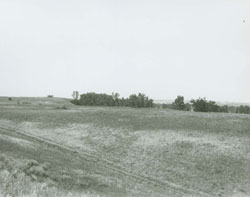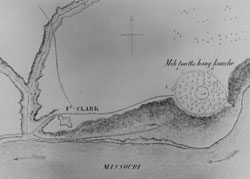We’ve launched a new web portal! Visit findhistory.nd.gov to search our collections.
Due to a road closure, the Killdeer Mountain Battlefield State Historic Site is temporarily closed.
The story of the site begins in the summer of 1822 when the Mandan built a village of earth-covered homes on the bluffs of the west bank of the Missouri River at the confluence of Chardon Creek and Clark's Creek. They called their new home Mitu'tahakto's (pronounced me-toot-a-hank-tosh), meaning first village or east village. The community overlooked gardens tended by the village women who grew crops of corn, beans, squash, pumpkins, and sunflowers. Tobacco was the only crop grown by men, who were primarily responsible for hunting bison and other game. After the fall harvest of these crops, the villagers moved to a winter village sheltered in the wooded Missouri river bottom. In the spring, they returned to Mitu'tahakto's to plant their crops.
 In 1830-1831, James Kipp, an employee of American Fur Company, built Fort Clark Trading Post south of the Mandan village in hopes of enhancing trade with the Indians. The rectangular fort measured 120 feet by 160 feet and was protected by a palisade. Inside the fort were a bourgeois house, where the head trader Francis A. Chardon lived, and other fur trade buildings. Between 1834 and 1839, Chardon kept a journal of his life at Fort Clark, which records the tragic history of the site.
In 1830-1831, James Kipp, an employee of American Fur Company, built Fort Clark Trading Post south of the Mandan village in hopes of enhancing trade with the Indians. The rectangular fort measured 120 feet by 160 feet and was protected by a palisade. Inside the fort were a bourgeois house, where the head trader Francis A. Chardon lived, and other fur trade buildings. Between 1834 and 1839, Chardon kept a journal of his life at Fort Clark, which records the tragic history of the site.
The first steamboat to journey to the Upper Missouri, the Yellow Stone, arrived at Fort Clark in 1832 and delivered 1,500 gallons of liquor and other trade goods. It returned to St. Louis carrying 100 packs of beaver pelts and bison robes from the fort. Important visitors to the site, such as artists Karl Bodmer and George Catlin and German scientist and explorer Prince Alexander Philipp Maximilian of Weid-Neuweid, also recorded life and death at the site in vivid detail.
Although steamboat traffic was important in transporting goods and visitors to the site, it also brought disease. On June 19, 1837, the steamboat St. Peters docked at Fort Clark carrying passengers infected with smallpox. Soon the disease swept through the Mandan village, killing about 90 percent of the inhabitants.  In mid-August, at the height of the smallpox epidemic, the survivors fled to join the Hidatsa near the mouth of the Knife River, abandoning the village at Fort Clark.
In mid-August, at the height of the smallpox epidemic, the survivors fled to join the Hidatsa near the mouth of the Knife River, abandoning the village at Fort Clark.
Although also devastated by the 1837 epidemic, approximately 50 percent of the Mandans' neighbors, the Arikara, survived. In 1838 they moved into the abandoned Mandan village to trade at Fort Clark and to grow their crops. Tragically, an outbreak of cholera in 1851 and another of smallpox in 1856 further reduced their population. The Arikara used the village as their summer home until they moved to Star Village near Fort Berthold in 1862.
Address:
Located 15 miles southwest of Washburn, ND.
follow: N Dakota 200 Alt W
Get Directions
Hours:
Open year-round.
Please note, there is no snow removal.
Contact SHSND:
phone: 701.328.2666
email: history@nd.gov